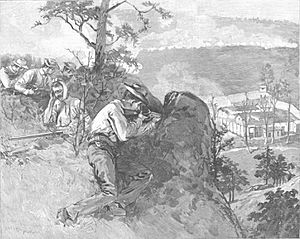Coal Wars facts for kids

|
|
| Date | c. 1890 – 1930 |
|---|---|
| Location | United States, especially West Virginia and Colorado |
| Also known as | Coal Mine Wars |
The Coal Wars were a series of fights and disagreements about work in coal mines in the United States. They happened mostly between 1890 and 1930. These conflicts mainly took place in the eastern parts of the U.S., especially in the Appalachian Mountains. There was also a lot of conflict in Colorado after the year 1900.
Contents
Why the Coal Wars Happened
The Coal Wars started because coal miners were treated unfairly. This happened during a time when many changes were taking place in the coal mining areas.
Company Towns and Worker Rights
Around 1870 to 1880, coal companies created "company towns." In these towns, the company owned everything, including the miners' homes and stores. Coal companies hired private detectives and even paid police officers. Their job was to keep union organizers out of the mining regions. To do this, these agents used threats, bothered workers, spied on them, and sometimes even committed murder.
Miners Fight Back
Throughout the early 1900s, coal miners tried to change this system. They went on many strikes, which are times when workers stop working to demand better conditions. Some important strikes included the Paint Creek–Cabin Creek strike of 1912 and the Battle of Evarts. Coal companies tried to stop these strikes using violent methods.
Miners and their families lived in fear of agents from the Baldwin–Felts Detective Agency. These agents were professional strikebreakers hired by the coal companies. During one conflict, these agents drove a heavily armored train through a camp of miners' tents at night. They fired a machine gun at the women, men, and children living there. They used a similar tactic during the Ludlow Massacre in Colorado the next year, which had even worse results.
Organizing for Change
By 1920, the United Mine Workers of America (UMWA) union had organized most of the coal miners in West Virginia and Colorado. However, the southern coalfields of West Virginia remained areas where coal companies had strong control and no unions.
Union Efforts in Mingo County
In early 1920, the UMWA president, John L. Lewis, decided to focus on organizing miners in Mingo County, West Virginia. Mingo County seemed like a better place to start than nearby Logan County, West Virginia. Logan County was controlled by Sheriff Don Chafin, who was strongly against unions and had his own armed group.
Mingo County's government was more independent. Some local leaders even supported the union. Cabell Testerman, the mayor of Matewan, was one of these supporters. He chose 27-year-old Sid Hatfield as the town's police chief. Hatfield had worked in the coal mines as a teenager and understood the miners' struggles. Even though he was not related to the famous Hatfield–McCoy feud Hatfields, he used that connection to his advantage. These men helped union organizers gain a foothold, and more and more miners in the county quickly joined the union.
Company Response to Unions
In response to these organizing efforts, coal companies tried everything to stop the union. One main way they fought the union was by firing miners who supported it. They would also "blacklist" them, meaning they made it hard for them to find work anywhere else. Then, they would kick these families out of their homes.
A lawyer for a coal company, S.B. Avis, explained their view: "It is like a servant lives at your house. If the servant leaves your employment, if you discharge him, you ask him to get out of the servants' quarters. It is a question of master and servant." This meant they saw miners as servants who could be easily removed from company property.
The UMWA set up tent camps for the homeless miner families. Soon, many unemployed and angry miners gathered in a small area along the Tug Fork River. Even with the companies trying to stop them, by early May, 3,000 out of 4,000 miners in Mingo had joined the union. At the Stone Mountain Coal Company mine near Matewan, every single worker joined the union. As a result, they were all fired and evicted from their homes.
West Virginia Coal Conflicts
The coal wars from the late 1800s to the early 1900s were a very important part of West Virginia's history.
Key Events in West Virginia
The Paint Creek–Cabin Creek strike of 1912 involved many labor leaders, including Mary Harris Jones, also known as "Mother" Jones. The next major event in West Virginia's mine wars was the Battle of Matewan on May 19, 1920. This conflict made the tensions between miners, their supporters, and coal companies even worse.
In West Virginia, the mine wars reached their peak at the Battle of Blair Mountain in 1921. This was an armed conflict between organized miners and detectives, police, and eventually, the United States Army. The miners lost the battle, and their efforts to form unions in the state were crushed. Miners were not allowed to organize again until the 1930s.
See also
 In Spanish: Guerras del Carbón para niños
In Spanish: Guerras del Carbón para niños

